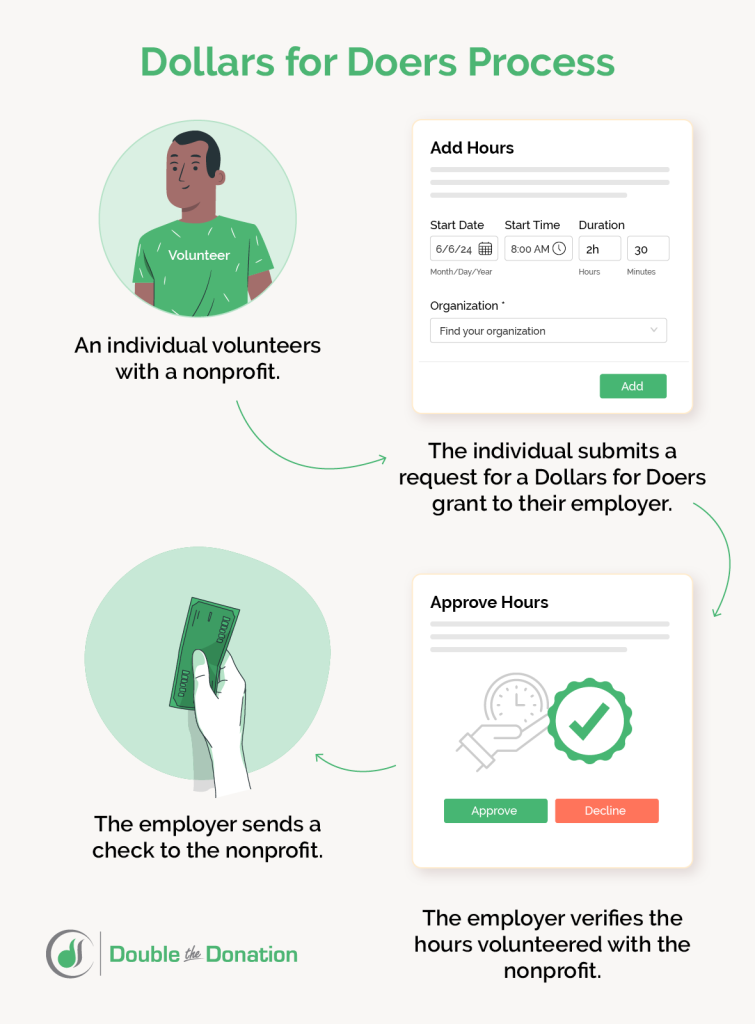
Your organization’s volunteers are one of your most valuable assets. Their free support helps you take care of administrative duties and pursue your overall mission, even if you have a limited number of paid staff members. In fact, Double the Donation’s volunteer statistics report found that about one-third of the entire nonprofit workforce is made up of volunteers.
You’ll need a strategic volunteer management plan to maximize the effects of your existing volunteers and recruit new eager individuals to your cause. To help, we’ve put together this handy list of tried-and-true tips for ensuring a successful volunteer program.
1. Strategically recruit volunteers.
To effectively manage your volunteers, you first need volunteers to manage! Good volunteer management starts during the recruitment process because it’s your first chance to present your nonprofit as a professional organization, connect with volunteers, and ensure you are recruiting the right people for your nonprofit.
To attract a wide range of passionate and skilled volunteers, try the following recruitment best practices:
- Offer a range of volunteer opportunities. Potential volunteers bring a wide range of skills and experience levels, meaning your volunteer opportunities should cater to numerous audiences. The more volunteer opportunities you offer, the more likely prospective volunteers will find a good fit and become involved with your organization.
- Leverage strategic networking. Volunteer recruitment relies on strategic networking. For example, your existing volunteers likely have friends and family who are also willing to help out. By encouraging volunteers to reach out to their personal networks, you have the power to expand your volunteer base exponentially. Alternatively, look into existing online support networks, such as volunteer-specific platforms like Mobilize.
- Look for and promote volunteer time off (VTO) opportunities. If volunteers know they’ll receive their regular paycheck for supporting your cause, they’ll be more inclined to do so. This means educating supporters about VTO opportunities and encouraging your current volunteers to look into their eligibility is essential.
By recruiting volunteers who are invested in your cause and have the right skills for their roles, you can set your management team up for success. After all, having a team that is motivated and ready to succeed can solve many common management challenges right off the bat.
2. Experiment with virtual volunteering.
With many nonprofit professionals working in remote or hybrid roles, it makes sense to offer supporters flexible volunteer opportunities they can do from home as well. This way, you can create an accessible volunteer program that still impacts your mission.
Here are a few common nonprofit needs that virtual volunteers can help out with:
- Technical skills: Do some of your supporters have experience with graphic design? What about copywriting? Volunteers with proficient art and writing skills can help out with your marketing and communications efforts from the comfort of their homes.
- Fundraising: With innovative virtual fundraising and digital communication tools, raising money for your cause online is easier than ever. You can either equip volunteers with a personalized online fundraising page to solicit donations from their networks or provide them with a list of contacts to request donations from, phone-banking style.
- Advocacy: If your organization has ties to social or political movements, online advocacy is a fantastic way for volunteers to get involved. For example, supporters can help circulate online petitions, participate in click-to-call campaigns, and more. Then, they can encourage their family and friends to do the same!
When you offer and promote virtual volunteer opportunities to your supporters, you drastically increase the number of individuals who are willing and able to help drive your mission forward.
3. Train and onboard volunteers.
Training volunteers is essential, but it’s easy for thorough onboarding efforts to fall by the wayside due to time and budget constraints. To create an effective and efficient volunteer training program, follow these best practices:
- Encourage virtual learning opportunities. Live-streamed virtual training and pre-recorded, on-demand resources can each be invaluable for nonprofits looking to train many volunteers quickly. For example, you can leverage free nonprofit training courses on topics such as fundraising, event planning, and even constituent relationship-building. This way, volunteers can engage with the content whenever is most convenient.
- Tailor your training to the average learner. When creating training materials, consider not just your volunteer roles but also who your average volunteer is. For example, if your volunteers tend to be older, you might be wary about including a heavily tech-based training program. On the other hand, younger supporters will likely be ready to jump on board with new technology and virtual training opportunities.
- Implement a volunteer mentorship program. One of the best ways for new volunteers to learn more about your mission and their role is to ask your seasoned volunteers for assistance. By implementing a volunteer mentorship program, you can help new volunteers integrate into your community, while also giving them hands-on experience with their new responsibilities.
Making sure your volunteers are well-trained for their respective positions is critical for building a confident, competent volunteer base you can trust with almost any responsibility.
4. Leverage volunteer grant programs.
Volunteer grant programs, also known as Dollars for Doers, can increase your volunteer program’s financial value. Through these programs, businesses provide grants to the nonprofits where their employees volunteer.
Although the exact process varies from business to business, Double the Donation’s guide to volunteer grants provides a basic overview:

- An individual volunteers with your organization and records the number of hours worked.
- If eligible for a volunteer grant, the volunteer submits a volunteer grant request.
- The volunteer’s employer reviews the request and confirms the individual’s completed volunteer hours.
- The company sends a monetary donation to your organization.
When volunteers see that their generous donations of time make an even greater impact through their volunteer grants, they’ll feel even more motivated to continue supporting your nonprofit. Plus, you’ll get some additional funding from corporate partners. It’s a win-win!
Additionally, help your supporters check if they qualify for VTO while checking for volunteer grant eligibility. Many businesses offer both VTO and volunteer grants, meaning some volunteers may be able to take time off work to volunteer and earn your nonprofit grant funding at the same time.
5. Invest in volunteer management software.
Having the right software in your toolkit is essential for leveling up your volunteer management processes.
To find a top-tier volunteer management software provider, be on the lookout for features like these:
- Communication tools: Effective communication with your volunteers is vital for proper program management. You’ll need to be able to reach out to new volunteers, convey shift information, and provide an easy way for individuals to ask questions.
- Peer-to-peer recruitment features: With peer-to-peer recruitment features, you can equip existing volunteers with the tools they need to request support from their own family, friends, and colleagues.
- Data reporting: Now that you’ve put together a strategic volunteer management program, you’ll be able to collect and analyze data to understand what is—and isn’t—working. With data reporting tools, you can explore powerful insights into your processes, showing you where there’s significant room for improvement and where you’re already thriving.
Volunteer management software can help any volunteer-backed organization, but it is especially important for nonprofits that wish to grow. Without the right tools, you’ll be able to scale your program by recruiting more volunteers, expanding roles, and implementing retention strategies, like showing proper volunteer recognition.
Volunteer management is a critical component of any volunteer-backed nonprofit. When you leverage these strategies, you’ll set your organization (and its volunteers!) up for continued success.
Just remember that equipping your team with the right tools is an important prerequisite for any efficient management strategy. Good luck!